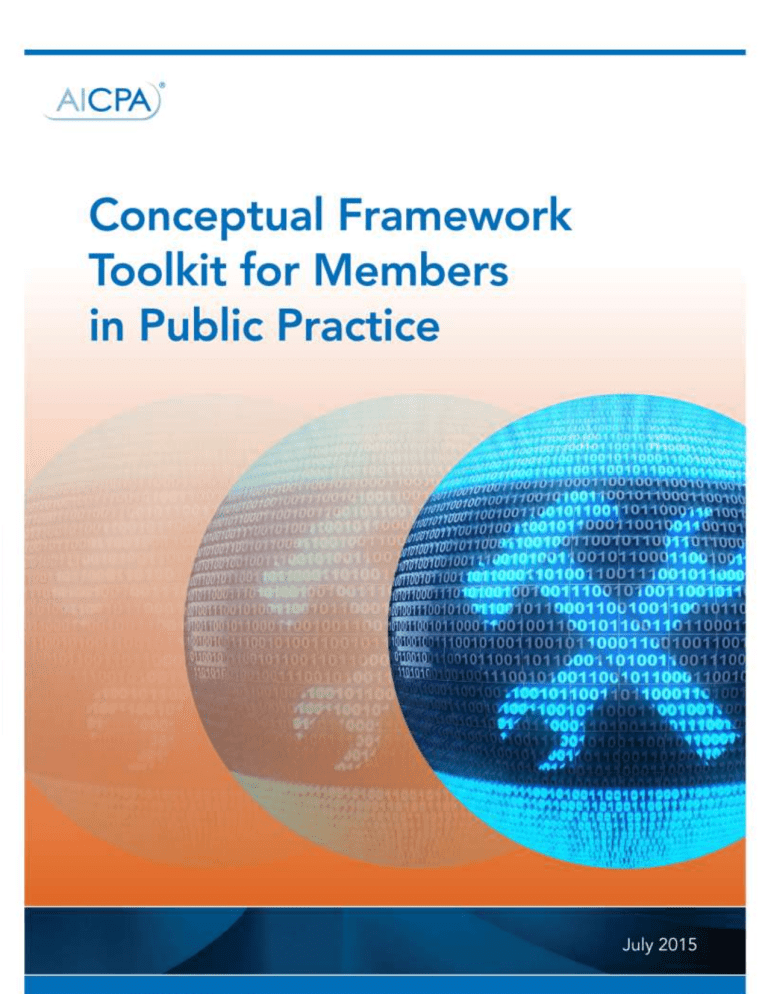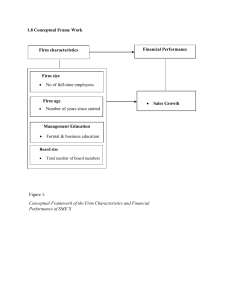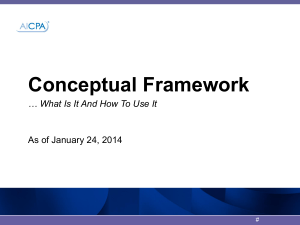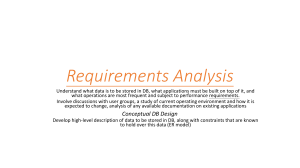
TABLE OF CONTENTS Introduction .......................................................................................................................................................... 2 Steps of the Conceptual Framework .................................................................................................................... 3 Step 1 — Identify Threats ................................................................................................................................ 3 Step 2 — Evaluate the Significance of a Threat ................................................................................................ 4 Step 3 — Identify and Apply Safeguards .......................................................................................................... 4 Step 4 — Evaluate the Effectiveness of Safeguards ......................................................................................... 4 Step 5 — Document Threats and Safeguards (Recommended) ........................................................................ 4 Conceptual Framework Flowchart ....................................................................................................................... 5 Conceptual Framework Worksheet ...................................................................................................................... 6 Conceptual Framework Examples ........................................................................................................................ 7 Contingent Fee Arrangement for a Consulting Engagement ........................................................................... 7 Commission Received by Partner's Son ........................................................................................................... 7 Assisting With the Sale of Client's Business ..................................................................................................... 8 Conceptual Framework Worksheet Example ....................................................................................................... 9 Conceptual Framework Examples ........................................................................................................................ 9 Instructions for Completing the Conceptual Framework Worksheet ........................................................... 10 INTRODUCTION The Application of the Conceptual Framework for Members in Public Practice and Ethical Conflicts interpretations under each rule require members to apply the Conceptual Framework for Members in Public Practice (the framework) (AICPA, Professional Standards, ET sec. 1.000.010) in cases for which there is no guidance in the AICPA Code of Professional Conduct (AICPA code) that addresses a particular relationship or circumstance. The framework cannot be used to overcome a prohibition or other requirement of the AICPA code. The framework incorporates a “threats and safeguards” approach, which is designed to assist members in analyzing relationships and circumstances that the AICPA code does not specifically address and in determining whether such relationships or circumstances may result in the violation of any of the rules in the AICPA code. This toolkit assists members in the implementation of the conceptual framework approach. Specifically, the toolkit includes the following: ► Steps of the conceptual framework to provide members with detailed guidance on what to do when applying the conceptual framework approach. ► A flowchart that serves as a visual aid for breaking down the steps of the conceptual framework approach. ► A worksheet to aid members with applying the steps of the conceptual framework. An example of how to use this worksheet is included in the toolkit. ► Examples of relationships or circumstances that are not addressed in the AICPA code and how the conceptual framework may be applied in such situations. Relationships or circumstances that members encounter that involve threats to independence may be analyzed using a separate toolkit entitled, Conceptual Framework Toolkit for Independence. Conceptual Framework Toolkit for Members in Public Practice │ 2 STEPS OF THE CONCEPTUAL FRAMEWORK Under the conceptual framework approach, members are required to (a) identify threats that could compromise the member’s compliance with the rules or be perceived by a reasonable and informed third party, who is aware of the relevant information as compromising the member’s compliance with the rules; (b) evaluate the significance of the threat(s) identified; (c) identify and apply appropriate safeguards, when necessary; and (d) evaluate whether such safeguards have been effective to eliminate or reduce significant threat(s) to an acceptable level. ► Integrity and Objectivity Rule The following sections provide detailed guidance on the steps members should perform when applying the conceptual framework approach. Under this approach, if appropriate safeguards cannot be applied to eliminate the threats or reduce them to an acceptable level, the member should (if possible) change the circumstance or relationship so that the threats are at an acceptable level or decline or discontinue the professional engagement. ► Commissions and Referral Fees Rule Step 1 — Identify Threats Members may encounter relationships or circumstances that threaten the member’s compliance with the rules. The rules and interpretations seek to address many situations; however, they cannot address all relationships or circumstances that may arise. Thus, when guidance is lacking, the AICPA code requires a member to evaluate that situation from the perspective of a reasonable and informed third party using the conceptual framework approach. ► Independence Rule1 ► General Standards Rule ► Compliance with Standards Rule ► Accounting Principles Rule ► Acts Discreditable Rule ► Contingent Fees Rule ► Advertising and Other Forms of Solicitation Rule ► Confidential Client Information Rule ► Form of Organization and Name Rule Paragraphs .10–.16 of the framework identify the following threats: adverse interest, advocacy, familiarity, management participation, self-interest, self-review, and undue influence. Threats are relationships or circumstances that could compromise a member’s compliance with the rules. For members in public practice, these rules, found in AICPA Professional Standards, are as follows: 1 A separate toolkit, “Conceptual Framework Toolkit for Independence,” is available to assist with analyzing relationships or circumstances that members encounter that involve threats to independence. Conceptual Framework Toolkit for Members in Public Practice │ 3 Step 2 — Evaluate the Significance of a Threat If a member has identified a threat resulting from a relationship or circumstance, the member will need to evaluate the significance of the threat. Members should evaluate identified threats, both individually and in the aggregate, because threats can have a cumulative effect on a member’s compliance with the rules. When evaluating the significance of a threat, the member should determine whether the threat is at an acceptable level, that is, would a reasonable and informed third party that is aware of the relationship or circumstance conclude that the threat identified would not compromise the member’s compliance with the rules. In addition, the member should consider both qualitative and quantitative factors, including whether any existing safeguards are in place that already reduce the threat to an acceptable level. If, after evaluating the significance of the threat, the member concludes that the threat is at an acceptable level, then the member is not required to evaluate the threat any further and may proceed with the professional service. However, if the member’s evaluation brings the member to the conclusion that the threat is not at an acceptable level, then the member must proceed to step 3, Identify and Apply Safeguards. Step 3 — Identify and Apply Safeguards If a member has evaluated the significance of a threat identified from a relationship or circumstance and concluded that the threat is not at an acceptable level, the member will need to identify safeguards that may be applied to eliminate or reduce the threat to an acceptable level. The member may identify safeguards that already exist or may need to identify new safeguards. It is possible that the member will need to apply only one safeguard that may eliminate or reduce multiple threats. However, in some cases, the member may need to apply multiple safeguards to eliminate or reduce one threat to an acceptable level. Safeguards may be created by the profession, legislation, or regulation, or may be implemented by the client or the firm. Examples of various safeguards within each category are presented in paragraphs .21–.23 of the framework. After identifying and applying safeguards, the member will need to proceed to step 4, Evaluate the Effectiveness of Safeguards, and use his or her professional judgment to evaluate whether the safeguards to be applied would be effective in eliminating or reducing the threat to an acceptable level. Step 4 — Evaluate the Effectiveness of Safeguards If the member concludes that threats are at an acceptable level after applying the identified safeguards, then the member may proceed with the professional service. However, if there are no safeguards that would eliminate the threat or reduce it to an acceptable level, or the member is unable to implement effective safeguards, the circumstance or relationship creating the threat should be changed, or the member should decline or terminate the professional engagement. If the member provides professional services under such circumstances, the member would compromise his or her compliance with the rules. Refer to paragraph .19 of the framework for examples of some factors that may aid in determining the effectiveness of a safeguard. Step 5 — Document Threats and Safeguards (Recommended) When safeguards are applied to eliminate or reduce significant threats to an acceptable level, the member is encouraged to document the identified threats and safeguards applied. Conceptual Framework Toolkit for Members in Public Practice │ 4 CONCEPTUAL FRAMEWORK FLOWCHART The following flowchart illustrates the steps of the conceptual framework: Conceptual Framework Toolkit for Members in Public Practice │ 5 CONCEPTUAL FRAMEWORK WORKSHEET When a member identifies a relationship or circumstance that may create threats to the member’s compliance with the rules, the member may wish to use the Conceptual Framework Worksheet to fulfill his or her compliance obligation under the AICPA code. Members may Summary of the Relationship or Circumstances Provide a description of the relationship or circumstance that may create threats to compliance with the rules Field A add additional relationships or circumstances to the worksheet as they are identified. Use “Tab” to navigate through the fields. (Instructions for Completing the Conceptual Framework Worksheet are on page 10 of the conceptual framework toolkit.) Step 1 Identify Threat(s) Describe the threat (adverse interest, advocacy, familiarity, management participation, self-interest, self-review and undue influence) associated with this relationship or circumstance. Step 2 Evaluate the Significance of Threat(s) Describe why the identified threats are or are not significant. Step 3 Identify and Apply Safeguards Describe the safeguards identified that will be applied to eliminate or reduce threats to an acceptable level. Step 4 Evaluate the Effectiveness of Safeguards Describe whether the safeguards applied would or would not eliminate or reduce the threat to an acceptable level. If you conclude that threats are not at an acceptable level, then document whether the firm can change the circumstance or relationship creating the threat or will decline or discontinue the engagement. Field B Field C Field D Field E Conceptual Framework Toolkit for Members in Public Practice│ 6 CONCEPTUAL FRAMEWORK EXAMPLES The following are examples of situations a member may encounter that the AICPA code does not address. These examples are not authoritative positions; rather, they demonstrate the use of the conceptual framework approach for members in public practice. Members should use professional judgment in determining whether threats are significant and, if so, determine whether safeguards would effectively reduce or eliminate those threats to an acceptable level. claim from the manufacturer’s retailers than might otherwise be appropriate in order to generate a larger contingent fee, which may compromise the member’s objectivity and integrity. Examples of situations that members may encounter that involve independence can be found in the “Conceptual Framework Toolkit for Independence.” ► Have the work reviewed by an individual within (or outside) the firm who is not associated with the consulting engagement. Contingent Fee Arrangement for a Consulting Engagement ► The retailer will receive specific information from the manufacturer permitting it to review the validity of the remuneration claims. A furniture manufacturer has a program that reimburses retailers a portion of the amount paid for advertisements placed in newspapers, circulars, and on websites if the advertising promotes the manufacturer’s products. To obtain reimbursement, the retailer supplies the manufacturer copies of the advertisements and its paid invoices. The manufacturer wants to periodically check the accuracy and validity of these reimbursements and engages the member to perform a consulting engagement whereby the member would review and confirm the accuracy of the information the retailers submit. The manufacturer agrees to pay the member 25 percent of any costs it recoups as a result of erroneous reimbursements. The member understands that there is not a direct prohibition for entering into a contingent fee arrangement with a nonattest client but decides to consider the matter under the conceptual framework to determine whether such a contingent fee arrangement may threaten his compliance with the rules. In doing so, the member identifies the following threats and safeguards that he will evaluate. Identified Threat(s): Self-interest threats to compliance with the “Contingent Fees Rule” and the “Integrity and Objectivity Rule” (AICPA, Professional Standards, ET secs. 1.510.001 and 1.100.001) are present. Specifically, so that the member might maximize the fees earned, the member may act in his or her own self-interest by seeking to obtain a larger refund Possible Safeguard(s): If the member concludes that the threats to compliance with the rules are significant, examples of safeguards the member may consider include the following: Commission Received by Partner’s Son A partner’s nondependent son is a full-time broker and earned a significant commission for securing a prime rental property for a large local retailer. The retailer has now contacted the partner’s firm to ask if the firm would perform its year-end financial statement audit. Although the AICPA code provides guidance regarding the receipt of a commission by a spouse in the “Services Performed by a Member’s Spouse for a Commission” interpretation (AICPA, Professional Standards, ET sec. 1.520.030), the member found no guidance on commissions earned by nondependent children. Because the fee earned by the son was significant, the member decided to consider the matter under the conceptual framework to determine whether the receipt of his son’s commission may threaten his compliance with the rules. In doing so, the member concludes that no threats are present because (1) the commission was already paid to his son before the firm was contacted about the potential audit services, and (2) the son has no involvement in the firm’s business or activities. Although no threats were identified, the member has decided to disclose the parental relationship to the prospective client to confirm that the retailer does not have any concerns. Conceptual Framework Toolkit for Members in Public Practice │ 7 CONCEPTUAL FRAMEWORK EXAMPLES continued Assisting With the Sale of Client’s Business A business-consulting client approaches the member to assist, in return for a success fee, with the identification of prospective buyers to purchase the client’s business and to represent the client during negotiations with any prospective buyers. Although the AICPA code provides independence guidance on providing corporate finance services to an attest client and prohibits (to a large degree) the receipt of a contingent fee from an attest client, the member cannot locate specific guidance on such services and contingent fee arrangements when the client is a nonattest client. The member decides to consider the matter under the conceptual framework to determine whether providing such services may threaten her compliance with the rules. In doing so, the member identifies the following possible threats and safeguards that she will evaluate. Identified Threat(s): The self-interest and advocacy threats to compliance with the “Integrity and Objectivity Rule” and the “Contingent Fees Rule” are present because the member may promote the client to the point that her objectivity is compromised in order to obtain a potential buyer and negotiate a purchase price that maximizes the success fee. Possible Safeguard(s): If the member concludes that the threats to compliance with the rules are significant, examples of safeguards the member may consider include the following: ► Have the work reviewed by an individual within (or outside) the firm who is not associated with the corporate finance services engagement. ► Have client management establish the criteria and specifications for the identification of potential buyers. ► Have client management make all significant decisions, including decisions during the negotiation process. Conceptual Framework Toolkit for Members in Public Practice │ 8 CONCEPTUAL FRAMEWORK WORKSHEET EXAMPLE The following example was used to complete the conceptual framework worksheet: Mary and John Smith just celebrated their 20th wedding anniversary. Mary is a consulting partner in a CPA firm, and John is the Senior Vice President of Finance at a company. A recruiter approached John with what he would consider his “dream job” as CFO of a well-respected and leading-edge company. He eagerly accepted the interview, which the recruiter scheduled for the following day. Over dinner that night, John tells Mary the exciting news. Instead of excitement, Mary begins to rub her head. She explains to John that for the past month she has been the lead partner on a major consulting project for the entity he will be interviewing with the next day. Mary explains that she is concerned about how his potential relationship with her consulting client may be perceived, so she excuses herself to review the AICPA code for guidance. Mary did not find any guidance that specifically described this situation. However, Mary decided to consult the conceptual framework and emailed her partners the following analysis for their input. Summary of the Relationship or Circumstances Provide a description of the relationship or circumstance that may create threats to compliance with the rules. Step 1 Identify Threat(s) Describe the threat adverse interest, advocacy, familiarity, management participation, selfinterest, self-review and undue influence associated with this relationship or circumstance. Step 2 Evaluate the Significance of Threat(s) Describe why the identified threats are or are not significant. Step 3 Identify and Apply Safeguards Describe the safeguards identified that will be applied to eliminate or reduce threats to an acceptable level. Step 4 Evaluate the Effectiveness of Safeguards Describe whether the safeguards applied would or would not eliminate or reduce the threat to an acceptable level. If you conclude that threats are not at an acceptable level, document whether the member or firm can change the circumstance or relationship creating the threat or will decline/discontinue the engagement. Mary is a partner of the firm, and her spouse is considering employment in a key position with a consulting client. The familiarity threat is present. The threat may be significant because Mary’s husband considers this his “dream job,” so Mary could be viewed as being too sympathetic to the client’s interests due to her husband’s consideration of employment with the client. If her husband is hired, she could be viewed as furthering his interests by becoming too accepting of the information the client gives her as part of her consulting engagement. The firm approached the consulting client and explained the conflict and that they would like to replace Mary on the consulting engagement during the interview process. She would remain off the engagement if her husband is offered the job. The consulting client agreed with the firm’s proposal. Removing Mary from the consulting engagement while her husband is interviewing with the client (and thereafter, if he is hired) and ensuring that Mary and the firm have no input or bearing on the client’s hiring process will enable both Mary and the firm to maintain the appropriate level of integrity and objectivity. Conclusion In addition, the firm will not assist the client with the hiring process of the new CFO. We have evaluated all identified threats, both individually and in the aggregate, and safeguards applied to eliminate or reduce any significant threats to an acceptable level as documented previously. Based on our evaluation, we have concluded that threats to compliance with the “Integrity and Objectivity Rule” are at an acceptable level. Conceptual Framework Toolkit for Members in Public Practice │ 9 INSTRUCTIONS FOR COMPLETING THE CONCEPTUAL FRAMEWORK WORKSHEET After you complete field E and select “Tab” you will be asked if you are done with the worksheet. If you answer “Yes” then field F will appear. If you answer “No” then another set of blank fields A–E will appear. When you are done completing field F select “Tab” and you will be asked if you want to save the worksheet as a separate file. Field A In this field, type in a summary of the relationship or circumstance that you believe may create a threat to comply with the rules. Select “Tab” to move to field B. Field B In this field, identify the threats that you believe exist and describe why you believe they exist. Select “Tab” to move to field C. Field C In this field, describe why you believe the threats you have identified in field B are or are not significant. If you believe the threats are not significant, then you can stop here. If you believe they are significant, then proceed to field D. If you believe they are significant, then select “Tab” to proceed to field D. Field D In this field, describe which existing and new safeguards you applied. Examples of possible safeguards are included in paragraphs .21–.23 of the “Conceptual Framework for Members in Public Practice.” Select “Tab” to move to field E. Field E In this field, describe why you believe the safeguards applied do or do not eliminate or reduce the threats to an acceptable level. If you conclude that threats are not at an acceptable level, document your plan of action. For example, do you plan to change the relationship or circumstance so that the threats no longer exist or are not significant, or do you plan to not perform the attest engagement? Consider consulting paragraph .19 of the framework for examples of factors, which may aid in determining the effectiveness of a safeguard. When you are done entering content into this field select “Tab” and you will be asked if you are finished with this table. You should select “No” if you have identified another relationship or circumstance that you believe may create a threat to complying with the rules. After selecting “No” another row will appear in the table for you to complete. If you select “Yes” a “Conclusion” row (filed F) will appear. Field F In this field, document your conclusion about whether threats identified that may compromise compliance with the rules are at an acceptable level. When you are done completing this field, select “Tab” and you will be asked if you want to save the worksheet as a separate file. Select “Yes” if you do and “No” if you don’t. Conceptual Framework Toolkit for Members in Public Practice │ 10 Conceptual Framework Toolkit for Members in Public Practice │ 11





